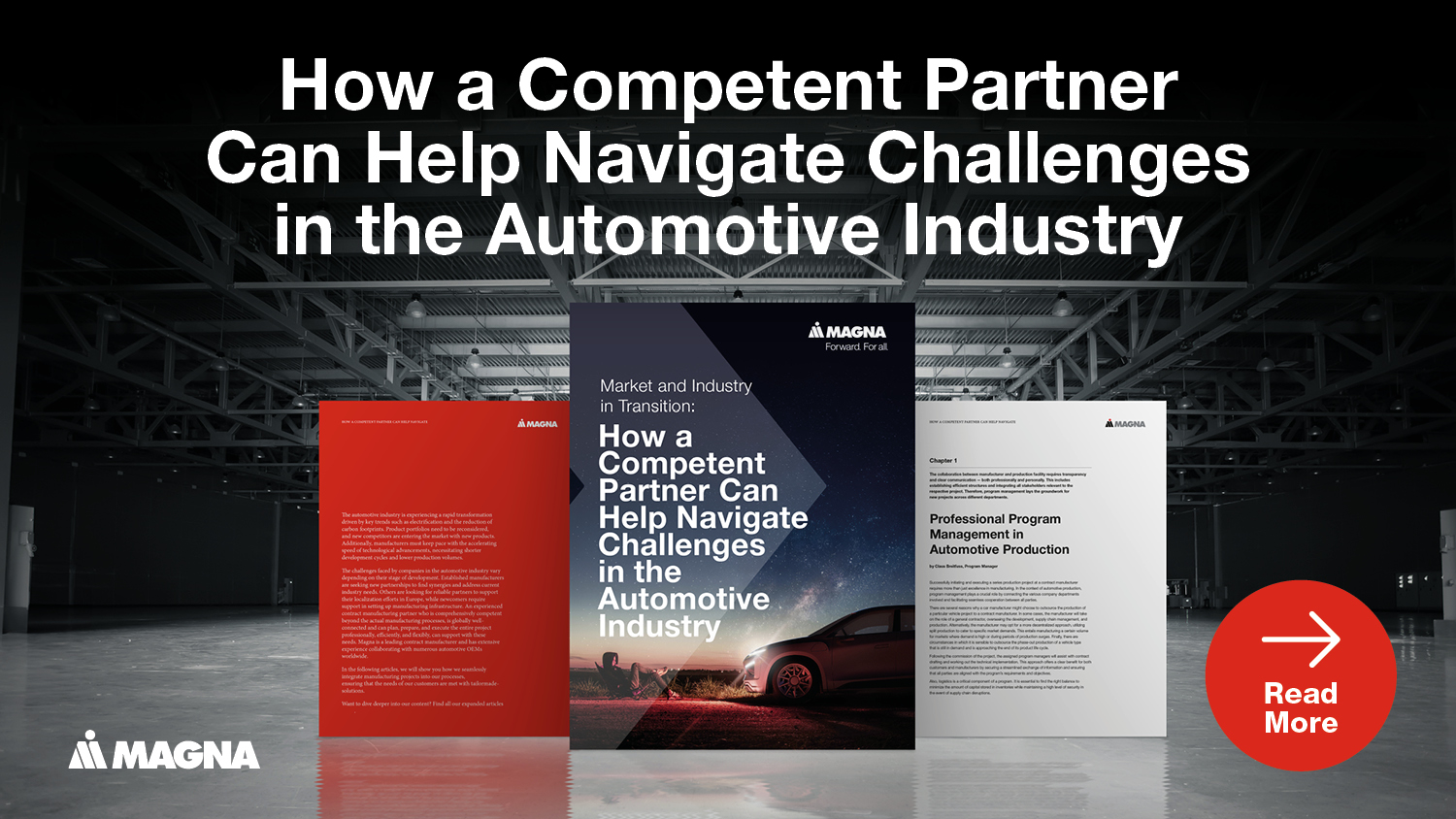
IT PLAYS A KEY ROLE LONG BEFORE AUTOMOTIVE MANUFACTURING BEGINS
IT plays a central role from the beginning: during the bidding phase, it must assess and evaluate the systems and processes required for the respective project. What is needed, what is already in place, and what do the processes and the IT integration look like?
This is the only way, the costs can be calculated, which form the basis for the offer. IT and its employees continue to play a central role in subsequent steps, such as the setup and launch of serial production, as well as the ongoing support and optimization of production.
A crucial aspect here is the scope of the automotive project, specifically which processes the contract manufacturer needs to cover. Naturally, there are differences in the IT landscape to be established—depending on whether it is the assembly of a "finished" product or the development is also already being taken over on behalf of the vehicle manufacturer.
NEW ENTRANTS REQUIRE DIFFERENT IT SOLUTIONS THAN TRADITIONAL VEHICLE MANUFACTURERS
When the customer is a company entering the automotive sector for the first time (so-called "New Entrants"), the tasks of our IT team differ from project set ups for traditional vehicle manufactures. Usually, the traditional OEM has a large IT landscape with proven processes already, which will naturally also be used for the new project. This reduces the effort for the contract manufacturer—especially if the new project is not the first one with that vehicle manufacturer.
New entrants require a different approach. They are often visionary and have innovative ideas, but they have limited experience in how to concretely approach the "adventure of automotive production." Moreover, they often lack the necessary IT structures and experience with IT processes. Here, a competent manufacturing partner can provide the necessary solutions: How are the required systems integrated, and what do the processes look like? This helps the new entrant avoid costly mistakes from the outset.
On the other hand, collaborating with new partners and exploring new ideas also offers the manufacturing partner the opportunity to learn and rethink processes. What can be done differently? Can different systems or methods be used? This also includes understanding,, for example why American vehicle manufacturers have a different approach than German manufacturers.
IT SYSTEM COMPATIBILITY AND INTEGRATION BETWEEN CONTRACT MANUFACTURING PARTNER
The IT system integration starts with the data exchange interfaces between the vehicle manufacturer and the manufacturing partner. Depending on the country or continent, different systems are commonly used. Magna, as a leading contract manufacturing partner, has developed its own processes and systems over the years.
For a manufacturing project, the relevant data, such as CAD data, design data, or bills of materials, are typically provided by the customer. These are usually represented in a product data management system and must be processed in a way that the contract manufacturing partner’s internal systems can understand and handle them.
The next step involves the entire logistics system that manages the processes. Each manufacturer has its own system, and Magna has developed a unique system in the industry that enables the production of multiple different vehicles on one assembly line.
Finally, there is the Manufacturing Execution System (MES), which is responsible for controlling, monitoring, and overseeing the production line. To streamline operations, the manufacturing partner optimizes the interfaces with customers to standardize processes using their own systems.
IT SYSTEMS ARE CRUCIAL TO SECURE THE PRODUCTION LINE
No IT system is 100% error-free. Sometimes, challenges can arise after some time in operation. This can create concern for non-experts: potentially, a fully IT-controlled manufacturing process could become more vulnerable to disruptions as the complexity of the underlying systems increases. Therefore, securing production is a top priority—particularly because downtime is costly.
This is why approximately one-third of the IT staff at Magna in Graz are dedicated to ensuring the smooth operation of automotive production. Much of their work occurs during production breaks, when updates are applied, and new security updates are implemented to keep the systems up to date. This maintenance happens daily, while more extensive updates are prepared over months and implemented over weekends to ensure that operations can resume seamlessly on Monday.
PROTECTION AGAINST EXTERNAL ATTACKS
From 2023 to 2024, the number of cyberattacks doubled—across all sectors. A large part of these attacks aims to access data and then resell it. Therefore, securing IT systems against external attacks is of paramount importance.
To achieve this, it is necessary to build a fail-safe architecture with multiple data centers, ensuring that no downtime is experienced after a hacker attack. Additionally, 24/7 monitoring of all events is required to detect and fend off potential threats early. The risk is particularly high for a contract manufacturer due to the larger number of external data interfaces (to customers, suppliers).
DATA SECURITY THROUGH DATA SEPARATION AND SEGREGATION OF DUTIES
Absolute data security is crucial for successful project execution. The vehicle manufacturer entrusts the contract manufacturing partner with sensitive information that must be safeguarded from unauthorized access, particularly from competitors. This level of data security is essential from the very start, beginning with the bidding phase. It involves strict separation of data for different projects to ensure confidentiality and protection.
Data permissions and access rights must be carefully managed to ensure that access is granted strictly based on necessity. This principle, known as segregation of duties (SoD), involves the clear separation of tasks. Key questions include: Who performs which tasks? Who assumes which roles? Who has access to specific IT permissions? These considerations determine which employees can access data from which customers. Roles must be distinctly separated. For example, someone who creates a supplier in the finance department should not also be responsible for approving invoices.
Alarm systems monitor task separation and raise alerts when overlaps are detected. This is data management. The technology behind this includes classic security systems such as encryption, firewalls, and similar precautions. In addition, segregation of duties is also part of many IT security standards such as ISO 27001 and TISAX.
The main risk is always human—every person makes mistakes and needs training. If data is strictly separated, this risk can be prevented from the start. This applies to a contract manufacturer just as much as to a supplier who must also keep their customers’ data separated. It also applies to the vehicle manufacturer’s own IT, where "data hygiene" is crucial. However, there are universally applicable standards set out in certifications that must be fulfilled and regularly checked in audits. All activities related to data and information security are bundled in a Security Operation Center (SOC), which is a central point that constantly monitors systems and triggers automated actions in case of anomalies.
DATA COLLECTION AND ANALYSIS PREVENT PROBLEMS IN ADVANCE
The collection and analysis of as much data as possible from the shop floor lines allows emerging disruptions to be detected early.
Since individual machines and devices already communicate autonomously—supported by AI—responses can be quicker and countermeasures can be taken faster. The concept of the Internet of Things (IoT) is already a reality here.
This proactive approach allows potential disruptions in the manufacturing process to be prevented before they occur, eliminating the need for reactive measures once a problem has already manifested. Additionally, it enhances manufacturing quality by detecting and addressing emerging deviations—such as dimensional inaccuracies during body manufacturing—before they become apparent in the final product.
THE CONTRACT MANUFACTURER´S IT SYSTEMS MUST SURPASS THOSE OF THE CUSTOMER´S PLANT
The IT challenges for a contract manufacturer are greater than those for the OEM's own plants. A contract manufacturer must be capable of serving all customers, requiring it to be faster, more flexible, and ultimately more cost-effective. Vehicle manufacturers will only outsource if it offers cost advantages or other benefits. A well-equipped manufacturing partner, such as Magna, can implement IT system changes up until the end of the process—something most manufacturers cannot achieve on their own production lines.
INDUSTRY 4.0: ARE WE TRULY IN THE ERA OF THE FOURTH INDUSTRIAL REVOLUTION?
The demand to optimize processes has existed for decades, but today's tools and instruments are far more advanced. While AI does not fundamentally change things overnight, it provides better access to data and allows evaluations to be obtained within seconds. Every industry aims to leverage the technologies and opportunities currently available to their fullest potential. This enables the interconnection of all systems and machines, a capability that did not exist in this form just a few years ago.
Unlike a revolution, the changes brought about by the comprehensive digitization of industrial production do not happen overnight. Instead, they represent a continuous evolution. As data is used more effectively, processes are managed and continuously improved, resulting in better efficiency, higher automation, and enhanced competitiveness. In this context, "digitalization" is more than just a buzzword; it signifies the ongoing effort to improve manufacturing processes—because, at their core, processes are driven by data.
Stay connected with Inside Automotive!

We want to hear from you
Send us your questions, thoughts and inquiries or engage in the conversation on social media.
Related Stories
Test First, Then Enter the European Market: Professional Battery Testing Examines More Than Just the Charging Curve
Blog
Stay connected
You can stay connected with Magna News and Stories through email alerts sent to your inbox in real time.




